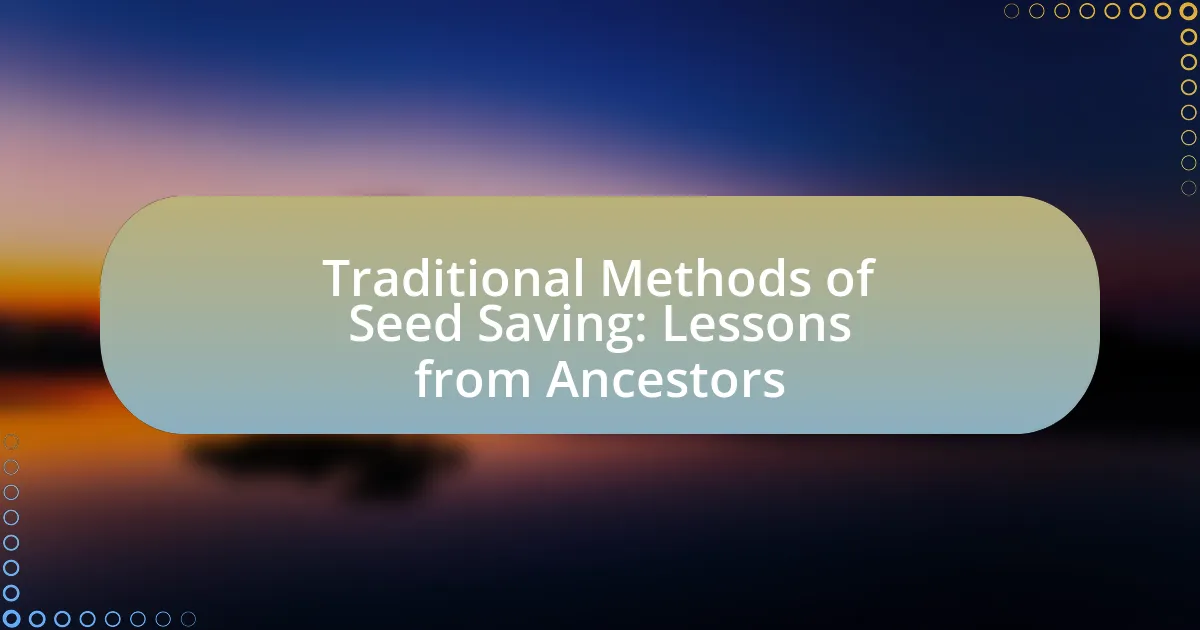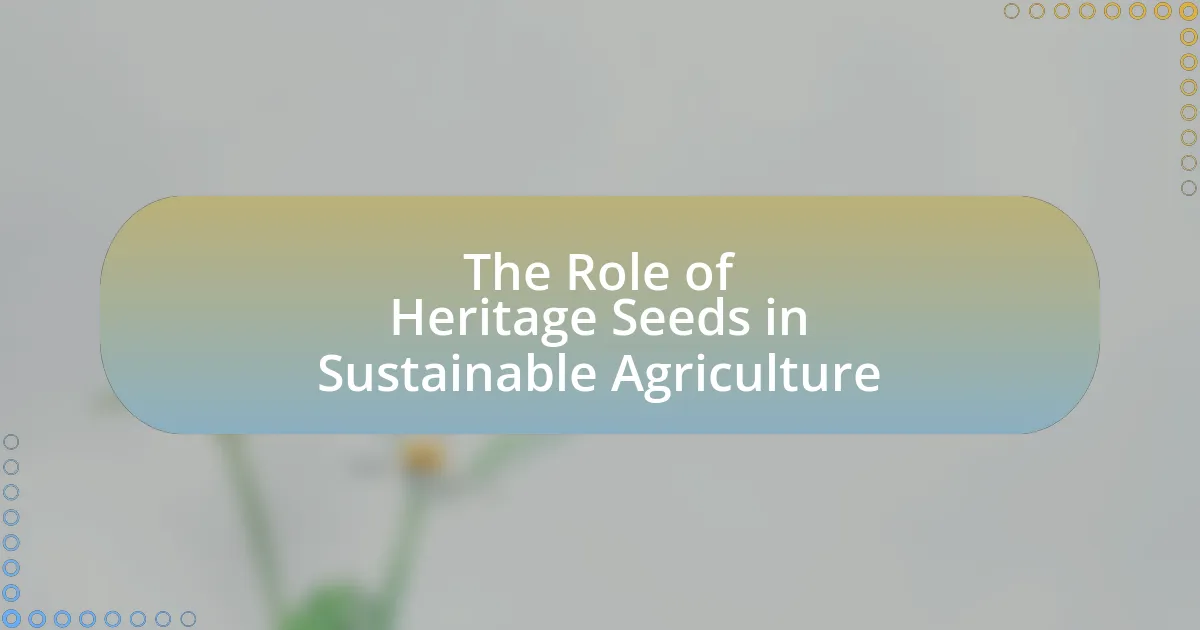A seed bank for heritage seeds is a facility dedicated to the collection, preservation, and storage of traditional plant varieties that have been cultivated over generations. This article outlines the significance of heritage seeds in maintaining genetic diversity and cultural heritage in agriculture, as well as the role of seed banks in safeguarding these vital resources against extinction. Key topics include the definition and importance of heritage seeds, the purpose and management of seed banks, effective methods for seed collection and preservation, and best practices for ensuring seed viability and community involvement. Additionally, the article addresses challenges faced in running a seed bank and strategies for overcoming them, providing a comprehensive guide for establishing a successful seed bank focused on heritage seeds.

What is a Seed Bank for Heritage Seeds?
A seed bank for heritage seeds is a facility or organization that collects, preserves, and stores seeds of traditional plant varieties that have been cultivated over generations. These seed banks aim to protect genetic diversity and ensure the availability of heritage seeds for future generations, as many of these varieties are at risk of extinction due to industrial agriculture practices and climate change. For example, the Seed Savers Exchange, founded in 1975, has preserved thousands of heirloom seed varieties, demonstrating the importance of such institutions in maintaining agricultural biodiversity.
Why are Heritage Seeds Important?
Heritage seeds are important because they preserve genetic diversity and cultural heritage in agriculture. These seeds, often passed down through generations, are adapted to local climates and conditions, which enhances resilience against pests and diseases. According to the Seed Savers Exchange, heritage seeds contribute to biodiversity, ensuring that a wide variety of plants are available for future generations. This genetic diversity is crucial for food security, as it allows for the development of new varieties that can withstand changing environmental conditions.
What defines a Heritage Seed?
A Heritage Seed is defined as a seed variety that has been passed down through generations, typically for at least 50 years, and is open-pollinated, meaning it can reproduce itself naturally. These seeds are valued for their genetic diversity, historical significance, and ability to adapt to local growing conditions. Heritage Seeds often have unique flavors and characteristics that are not found in modern hybrid varieties, making them important for preserving agricultural biodiversity.
How do Heritage Seeds differ from other seed types?
Heritage seeds differ from other seed types primarily in their genetic makeup and cultivation history. Heritage seeds, also known as heirloom seeds, are open-pollinated varieties that have been passed down through generations, often for 50 years or more, maintaining their unique traits and flavors. In contrast, other seed types, such as hybrid seeds, are created through controlled pollination and often exhibit traits that are not stable over generations, leading to variability in the offspring. Heritage seeds are valued for their biodiversity, adaptability to local conditions, and the preservation of traditional agricultural practices, which contrasts with the commercial focus of many modern seed types that prioritize uniformity and yield.
What is the Purpose of a Seed Bank?
The purpose of a seed bank is to preserve genetic diversity by storing seeds for future use. Seed banks safeguard a wide variety of plant species, ensuring that they can be reintroduced or cultivated in the future, particularly in response to environmental changes, agricultural needs, or loss of biodiversity. For instance, the Svalbard Global Seed Vault, established in 2008, serves as a global backup for seed collections, protecting over a million seed samples from around the world, thereby reinforcing the importance of seed banks in conservation efforts.
How does a Seed Bank contribute to biodiversity?
A seed bank contributes to biodiversity by preserving a wide variety of plant genetic material, which is essential for maintaining ecosystem resilience and adaptability. By storing seeds from diverse plant species, seed banks safeguard against the loss of genetic diversity caused by habitat destruction, climate change, and other environmental pressures. For instance, the Svalbard Global Seed Vault, which houses over a million seed samples, serves as a global backup for crop diversity, ensuring that vital genetic resources remain available for future agricultural and ecological needs. This preservation of genetic diversity is crucial for breeding programs aimed at developing new crop varieties that can withstand pests, diseases, and changing climate conditions.
What role does a Seed Bank play in agriculture?
A Seed Bank plays a crucial role in agriculture by preserving genetic diversity and ensuring the availability of various plant species for future cultivation. Seed Banks store seeds from a wide range of crops, including heritage and heirloom varieties, which are vital for maintaining biodiversity and adapting to changing environmental conditions. For instance, the Svalbard Global Seed Vault, established in 2008, safeguards over a million seed samples from around the world, acting as a global backup for food security. This preservation helps protect against the loss of plant varieties due to climate change, disease, or other agricultural challenges, thereby supporting sustainable farming practices and food systems.

How to Start a Seed Bank for Heritage Seeds?
To start a seed bank for heritage seeds, first, identify and collect a diverse range of heritage seed varieties that are open-pollinated and non-hybrid. This ensures genetic diversity and the ability to save seeds for future planting. Next, create a suitable storage environment by maintaining low humidity and cool temperatures, ideally between 32°F and 41°F (0°C to 5°C), to prolong seed viability. Additionally, label each seed packet with detailed information, including the seed variety, collection date, and source, to maintain accurate records. Research indicates that proper storage conditions can significantly extend seed life, with some seeds remaining viable for decades when stored correctly.
What Initial Steps are Needed to Create a Seed Bank?
To create a seed bank, the initial steps include selecting a suitable location, determining the types of seeds to store, and establishing proper storage conditions. A suitable location should be secure, accessible, and have a stable environment to prevent seed degradation. The types of seeds to store should focus on heritage varieties that are at risk of extinction, ensuring biodiversity preservation. Proper storage conditions involve maintaining low temperatures and humidity levels, as research indicates that seeds stored at 0°C and 20% humidity can remain viable for decades.
How do you select the right location for a Seed Bank?
To select the right location for a seed bank, prioritize areas with stable temperatures and low humidity to ensure seed viability. Ideal locations often include underground facilities or climate-controlled environments that maintain consistent conditions, as fluctuations can lead to seed degradation. Research indicates that seed banks located in regions with minimal natural disasters, such as earthquakes or floods, enhance long-term preservation efforts. For instance, the Svalbard Global Seed Vault, situated in a remote Arctic location, benefits from permafrost, which naturally aids in seed preservation by providing a cold and stable environment.
What resources are necessary for establishing a Seed Bank?
To establish a Seed Bank, essential resources include a controlled environment for seed storage, appropriate seed collection tools, and a database for tracking seed varieties. A controlled environment, such as a cold storage facility, is crucial for maintaining seed viability, as seeds require specific temperature and humidity levels to remain viable over time. Seed collection tools, including hand tools and containers, are necessary for the careful harvesting and handling of seeds to prevent damage. Additionally, a comprehensive database is vital for cataloging seed varieties, tracking their origins, and managing their storage conditions, ensuring that genetic diversity is preserved effectively.
How do you Collect and Preserve Heritage Seeds?
To collect and preserve heritage seeds, first, select mature seeds from healthy plants, ensuring they are open-pollinated varieties. After harvesting, clean the seeds to remove any debris and allow them to dry in a cool, dark place for several days to prevent mold. Once dried, store the seeds in airtight containers, such as glass jars or vacuum-sealed bags, and label them with the variety name and collection date. For optimal preservation, keep the containers in a cool, dark, and dry environment, ideally at temperatures below 50°F (10°C) and low humidity levels. This method is supported by the fact that proper storage conditions can significantly extend seed viability, with some heritage seeds remaining viable for decades when stored correctly.
What methods are effective for seed collection?
Effective methods for seed collection include hand harvesting, using seed traps, and employing mechanical seed harvesters. Hand harvesting allows for careful selection of mature seeds, ensuring quality and viability. Seed traps, such as nets or bags, can capture seeds that naturally fall from plants, providing a passive collection method. Mechanical seed harvesters are efficient for large-scale operations, enabling the collection of seeds from extensive areas quickly. These methods are validated by agricultural practices that emphasize the importance of seed quality and viability in maintaining genetic diversity in seed banks.
How can seeds be properly stored for long-term preservation?
Seeds can be properly stored for long-term preservation by keeping them in a cool, dry, and dark environment. This method significantly reduces moisture and temperature fluctuations, which can lead to seed degradation. For optimal results, seeds should be placed in airtight containers, such as glass jars or vacuum-sealed bags, to prevent exposure to humidity and pests. Additionally, maintaining a consistent temperature below 50°F (10°C) is recommended, as studies show that lower temperatures can extend seed viability significantly. For example, seeds stored at 32°F (0°C) can remain viable for decades, while those at room temperature may only last a few years.

What Best Practices Should be Followed in Managing a Seed Bank?
Best practices in managing a seed bank include maintaining genetic diversity, ensuring proper storage conditions, and implementing regular viability testing. Maintaining genetic diversity is crucial as it enhances resilience against pests and diseases, which is supported by studies showing that diverse gene pools can better withstand environmental changes. Proper storage conditions, such as controlling temperature and humidity, are essential to prolong seed longevity; for instance, seeds stored at low temperatures can remain viable for decades. Regular viability testing, conducted every few years, ensures that seeds retain their germination capacity, with research indicating that seeds lose viability over time, emphasizing the need for periodic assessments.
How do you Maintain Seed Viability Over Time?
To maintain seed viability over time, store seeds in a cool, dry, and dark environment. This method slows down the metabolic processes of the seeds, thereby extending their lifespan. Research indicates that seeds stored at temperatures below 50°F (10°C) and with low humidity levels (around 20% relative humidity) can remain viable for several years, with some seeds lasting decades under optimal conditions. Proper packaging, such as using airtight containers, also helps protect seeds from moisture and pests, further enhancing their longevity.
What are the best practices for seed testing and germination?
The best practices for seed testing and germination include conducting a germination test, ensuring proper storage conditions, and using high-quality seeds. A germination test involves placing a sample of seeds in a controlled environment to determine their viability, typically using a moist paper towel or soil medium. Proper storage conditions, such as maintaining low humidity and stable temperatures, help preserve seed viability over time. High-quality seeds, often sourced from reputable suppliers, are more likely to germinate successfully. Research indicates that seeds stored at temperatures below 50°F and relative humidity below 20% can maintain viability for several years, supporting the effectiveness of these practices.
How often should seeds be replaced or refreshed?
Seeds should be replaced or refreshed every 3 to 5 years to maintain their viability and genetic diversity. This timeframe is based on the fact that seed viability decreases over time due to factors such as moisture, temperature, and storage conditions. Research indicates that many seeds can lose their germination potential significantly after this period, making it essential to periodically refresh the seed stock to ensure successful planting and cultivation.
What Challenges Might Arise in Running a Seed Bank?
Running a seed bank can present several challenges, including maintaining genetic diversity, ensuring proper storage conditions, and managing funding and resources. Genetic diversity is crucial for the long-term viability of plant species, and a lack of it can lead to increased vulnerability to diseases and environmental changes. Proper storage conditions, such as temperature and humidity control, are essential to prevent seed degradation; for instance, seeds stored at inappropriate temperatures can lose viability within a few years. Additionally, securing consistent funding and resources is often difficult, as seed banks rely on grants, donations, and partnerships to sustain operations and expand their collections. These challenges highlight the complexities involved in effectively managing a seed bank dedicated to preserving heritage seeds.
How can you address issues of contamination or seed loss?
To address issues of contamination or seed loss, implement strict seed cleaning protocols and maintain controlled storage conditions. Seed cleaning involves removing debris and ensuring that seeds are free from pathogens, which can be achieved through methods such as air blowing, screening, and washing. Controlled storage conditions, including low humidity and stable temperatures, help preserve seed viability and prevent mold growth. Research indicates that seeds stored at temperatures below 5°C can maintain viability for decades, significantly reducing the risk of loss. Additionally, regular monitoring of seed health and periodic germination tests can identify potential issues early, allowing for timely intervention.
What strategies can be implemented to ensure community involvement?
To ensure community involvement in creating a seed bank for heritage seeds, strategies such as organizing workshops, forming partnerships with local organizations, and utilizing social media for outreach can be implemented. Workshops educate community members about the importance of heritage seeds and provide hands-on experience in seed saving and cultivation. Partnerships with local schools, gardening clubs, and agricultural organizations can enhance resources and broaden participation. Social media platforms can effectively disseminate information, promote events, and engage a wider audience, fostering a sense of community ownership and responsibility towards the seed bank initiative.
What Tips Can Help Ensure the Success of Your Seed Bank?
To ensure the success of your seed bank, focus on proper seed storage, regular inventory management, and community engagement. Proper seed storage involves maintaining optimal temperature and humidity levels to preserve seed viability, as seeds stored in cool, dry conditions can remain viable for years. Regular inventory management ensures that seeds are rotated and tested for germination rates, which is crucial for maintaining seed quality. Community engagement fosters collaboration and knowledge sharing, enhancing the seed bank’s resources and outreach. These practices are supported by studies indicating that effective seed storage can increase longevity and germination rates, while community involvement can significantly enhance the sustainability of seed banks.





